Business Environment Analysis of Nestle
VerifiedAdded on 2020/02/03
|14
|5007
|262
Report
AI Summary
This report analyzes the business environment of Nestle, a leading multinational food and drink company. It covers various aspects including the organizational purposes, stakeholder objectives, the impact of national and global factors, and the competitive landscape in which Nestle operates. The report highlights how Nestle navigates its responsibilities towards stakeholders while adapting to economic systems, fiscal and monetary policies, and competition regulations. Additionally, it discusses the significance of international trade and the influence of European Union policies on Nestle's operations in the UK.
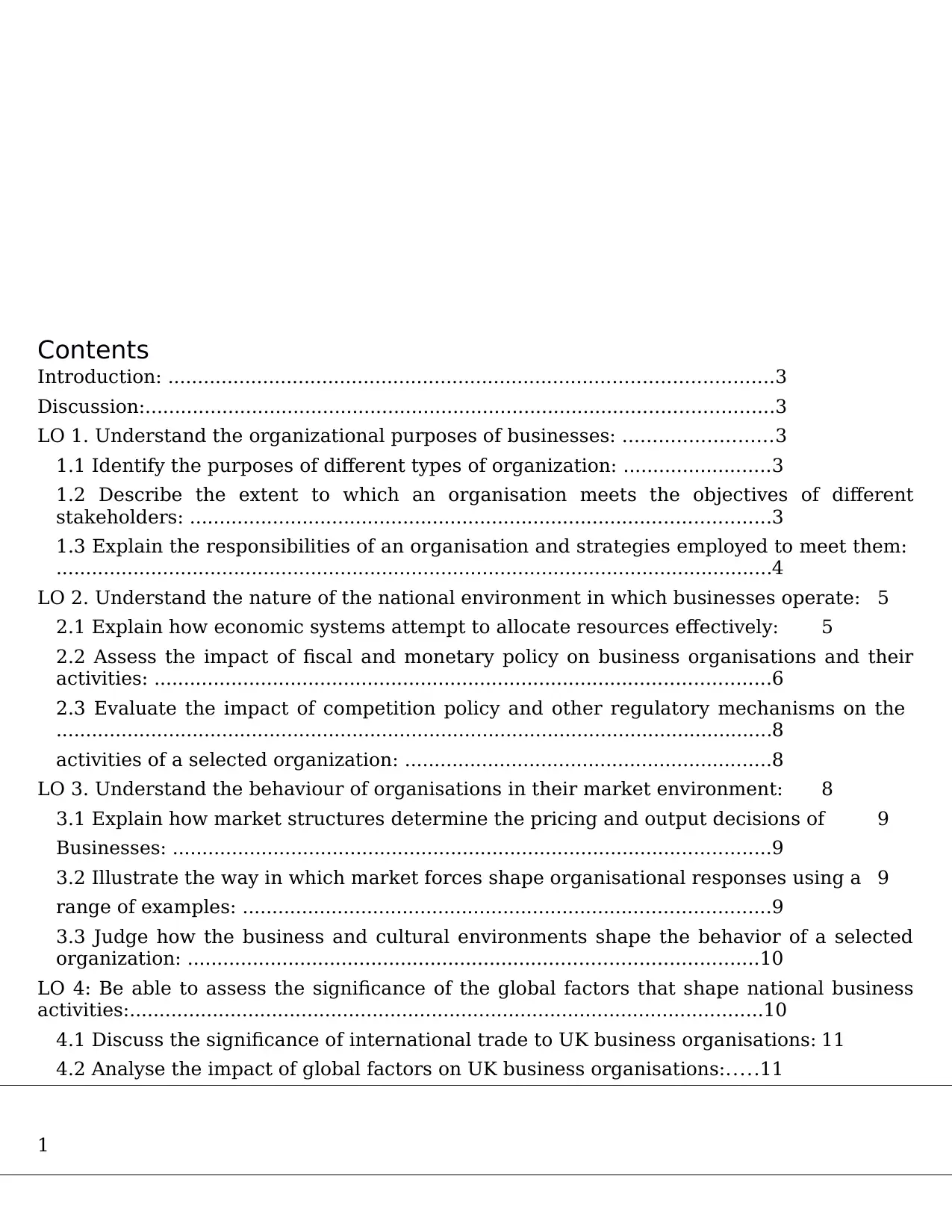
Contents
Introduction: ......................................................................................................3
Discussion:..........................................................................................................3
LO 1. Understand the organizational purposes of businesses: .........................3
1.1 Identify the purposes of different types of organization: .........................3
1.2 Describe the extent to which an organisation meets the objectives of different
stakeholders: ..................................................................................................3
1.3 Explain the responsibilities of an organisation and strategies employed to meet them:
.........................................................................................................................4
LO 2. Understand the nature of the national environment in which businesses operate: 5
2.1 Explain how economic systems attempt to allocate resources effectively: 5
2.2 Assess the impact of fiscal and monetary policy on business organisations and their
activities: ........................................................................................................6
2.3 Evaluate the impact of competition policy and other regulatory mechanisms on the
.........................................................................................................................8
activities of a selected organization: ..............................................................8
LO 3. Understand the behaviour of organisations in their market environment: 8
3.1 Explain how market structures determine the pricing and output decisions of 9
Businesses: .....................................................................................................9
3.2 Illustrate the way in which market forces shape organisational responses using a 9
range of examples: .........................................................................................9
3.3 Judge how the business and cultural environments shape the behavior of a selected
organization: ................................................................................................10
LO 4: Be able to assess the significance of the global factors that shape national business
activities:...........................................................................................................10
4.1 Discuss the significance of international trade to UK business organisations: 11
4.2 Analyse the impact of global factors on UK business organisations:.....11
1
Introduction: ......................................................................................................3
Discussion:..........................................................................................................3
LO 1. Understand the organizational purposes of businesses: .........................3
1.1 Identify the purposes of different types of organization: .........................3
1.2 Describe the extent to which an organisation meets the objectives of different
stakeholders: ..................................................................................................3
1.3 Explain the responsibilities of an organisation and strategies employed to meet them:
.........................................................................................................................4
LO 2. Understand the nature of the national environment in which businesses operate: 5
2.1 Explain how economic systems attempt to allocate resources effectively: 5
2.2 Assess the impact of fiscal and monetary policy on business organisations and their
activities: ........................................................................................................6
2.3 Evaluate the impact of competition policy and other regulatory mechanisms on the
.........................................................................................................................8
activities of a selected organization: ..............................................................8
LO 3. Understand the behaviour of organisations in their market environment: 8
3.1 Explain how market structures determine the pricing and output decisions of 9
Businesses: .....................................................................................................9
3.2 Illustrate the way in which market forces shape organisational responses using a 9
range of examples: .........................................................................................9
3.3 Judge how the business and cultural environments shape the behavior of a selected
organization: ................................................................................................10
LO 4: Be able to assess the significance of the global factors that shape national business
activities:...........................................................................................................10
4.1 Discuss the significance of international trade to UK business organisations: 11
4.2 Analyse the impact of global factors on UK business organisations:.....11
1
Paraphrase This Document
Need a fresh take? Get an instant paraphrase of this document with our AI Paraphraser
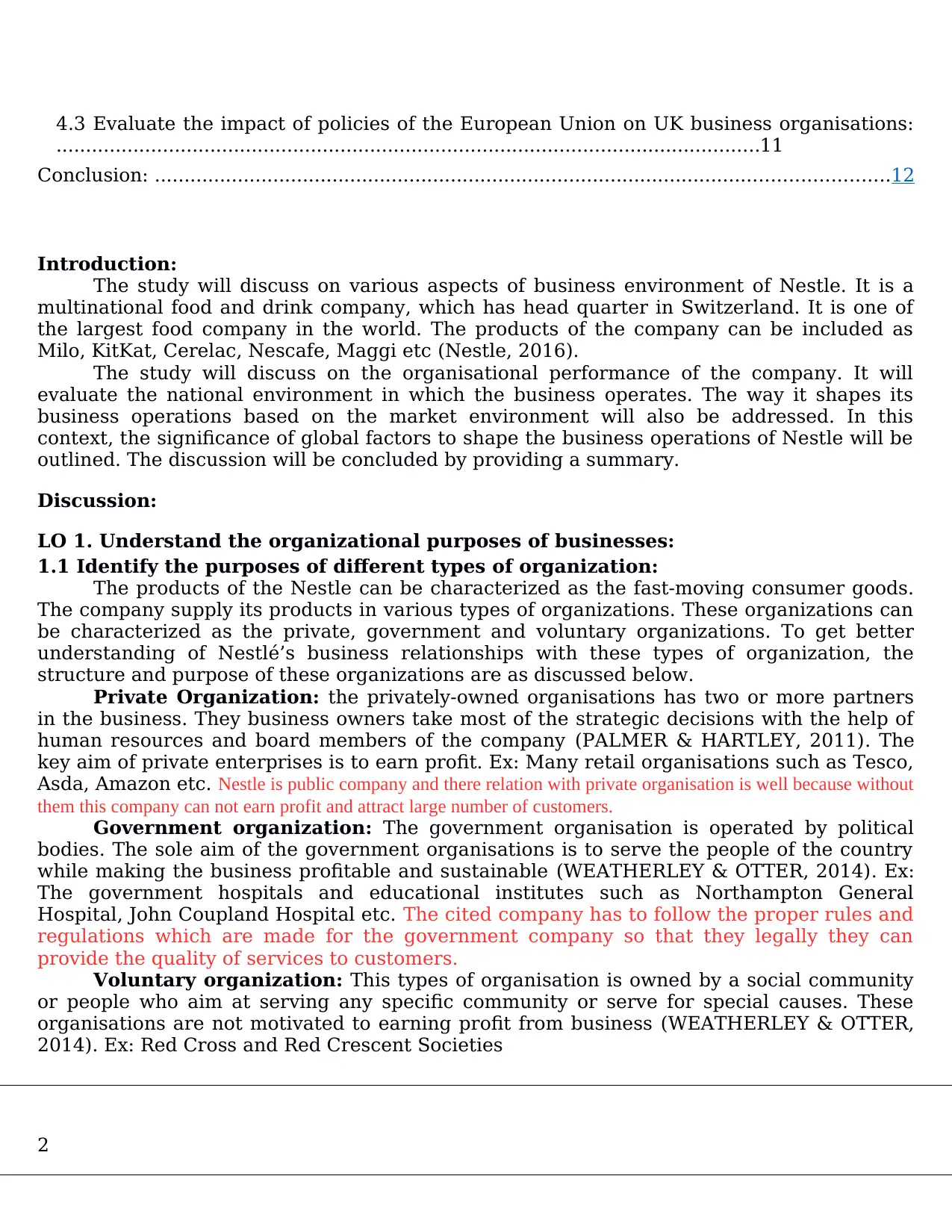
4.3 Evaluate the impact of policies of the European Union on UK business organisations:
.......................................................................................................................11
Conclusion: ............................................................................................................................12
Introduction:
The study will discuss on various aspects of business environment of Nestle. It is a
multinational food and drink company, which has head quarter in Switzerland. It is one of
the largest food company in the world. The products of the company can be included as
Milo, KitKat, Cerelac, Nescafe, Maggi etc (Nestle, 2016).
The study will discuss on the organisational performance of the company. It will
evaluate the national environment in which the business operates. The way it shapes its
business operations based on the market environment will also be addressed. In this
context, the significance of global factors to shape the business operations of Nestle will be
outlined. The discussion will be concluded by providing a summary.
Discussion:
LO 1. Understand the organizational purposes of businesses:
1.1 Identify the purposes of different types of organization:
The products of the Nestle can be characterized as the fast-moving consumer goods.
The company supply its products in various types of organizations. These organizations can
be characterized as the private, government and voluntary organizations. To get better
understanding of Nestlé’s business relationships with these types of organization, the
structure and purpose of these organizations are as discussed below.
Private Organization: the privately-owned organisations has two or more partners
in the business. They business owners take most of the strategic decisions with the help of
human resources and board members of the company (PALMER & HARTLEY, 2011). The
key aim of private enterprises is to earn profit. Ex: Many retail organisations such as Tesco,
Asda, Amazon etc. Nestle is public company and there relation with private organisation is well because without
them this company can not earn profit and attract large number of customers.
Government organization: The government organisation is operated by political
bodies. The sole aim of the government organisations is to serve the people of the country
while making the business profitable and sustainable (WEATHERLEY & OTTER, 2014). Ex:
The government hospitals and educational institutes such as Northampton General
Hospital, John Coupland Hospital etc. The cited company has to follow the proper rules and
regulations which are made for the government company so that they legally they can
provide the quality of services to customers.
Voluntary organization: This types of organisation is owned by a social community
or people who aim at serving any specific community or serve for special causes. These
organisations are not motivated to earning profit from business (WEATHERLEY & OTTER,
2014). Ex: Red Cross and Red Crescent Societies
2
.......................................................................................................................11
Conclusion: ............................................................................................................................12
Introduction:
The study will discuss on various aspects of business environment of Nestle. It is a
multinational food and drink company, which has head quarter in Switzerland. It is one of
the largest food company in the world. The products of the company can be included as
Milo, KitKat, Cerelac, Nescafe, Maggi etc (Nestle, 2016).
The study will discuss on the organisational performance of the company. It will
evaluate the national environment in which the business operates. The way it shapes its
business operations based on the market environment will also be addressed. In this
context, the significance of global factors to shape the business operations of Nestle will be
outlined. The discussion will be concluded by providing a summary.
Discussion:
LO 1. Understand the organizational purposes of businesses:
1.1 Identify the purposes of different types of organization:
The products of the Nestle can be characterized as the fast-moving consumer goods.
The company supply its products in various types of organizations. These organizations can
be characterized as the private, government and voluntary organizations. To get better
understanding of Nestlé’s business relationships with these types of organization, the
structure and purpose of these organizations are as discussed below.
Private Organization: the privately-owned organisations has two or more partners
in the business. They business owners take most of the strategic decisions with the help of
human resources and board members of the company (PALMER & HARTLEY, 2011). The
key aim of private enterprises is to earn profit. Ex: Many retail organisations such as Tesco,
Asda, Amazon etc. Nestle is public company and there relation with private organisation is well because without
them this company can not earn profit and attract large number of customers.
Government organization: The government organisation is operated by political
bodies. The sole aim of the government organisations is to serve the people of the country
while making the business profitable and sustainable (WEATHERLEY & OTTER, 2014). Ex:
The government hospitals and educational institutes such as Northampton General
Hospital, John Coupland Hospital etc. The cited company has to follow the proper rules and
regulations which are made for the government company so that they legally they can
provide the quality of services to customers.
Voluntary organization: This types of organisation is owned by a social community
or people who aim at serving any specific community or serve for special causes. These
organisations are not motivated to earning profit from business (WEATHERLEY & OTTER,
2014). Ex: Red Cross and Red Crescent Societies
2
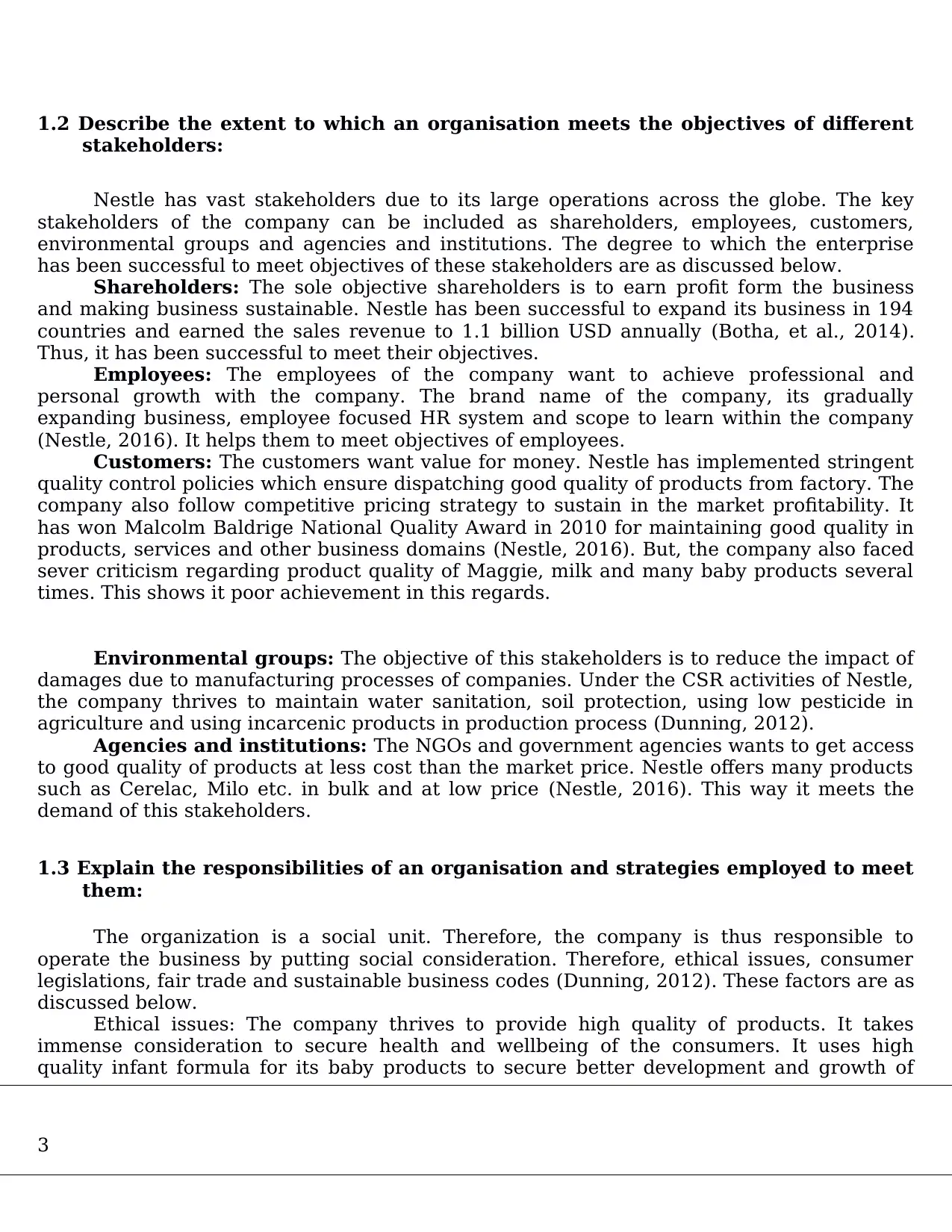
1.2 Describe the extent to which an organisation meets the objectives of different
stakeholders:
Nestle has vast stakeholders due to its large operations across the globe. The key
stakeholders of the company can be included as shareholders, employees, customers,
environmental groups and agencies and institutions. The degree to which the enterprise
has been successful to meet objectives of these stakeholders are as discussed below.
Shareholders: The sole objective shareholders is to earn profit form the business
and making business sustainable. Nestle has been successful to expand its business in 194
countries and earned the sales revenue to 1.1 billion USD annually (Botha, et al., 2014).
Thus, it has been successful to meet their objectives.
Employees: The employees of the company want to achieve professional and
personal growth with the company. The brand name of the company, its gradually
expanding business, employee focused HR system and scope to learn within the company
(Nestle, 2016). It helps them to meet objectives of employees.
Customers: The customers want value for money. Nestle has implemented stringent
quality control policies which ensure dispatching good quality of products from factory. The
company also follow competitive pricing strategy to sustain in the market profitability. It
has won Malcolm Baldrige National Quality Award in 2010 for maintaining good quality in
products, services and other business domains (Nestle, 2016). But, the company also faced
sever criticism regarding product quality of Maggie, milk and many baby products several
times. This shows it poor achievement in this regards.
Environmental groups: The objective of this stakeholders is to reduce the impact of
damages due to manufacturing processes of companies. Under the CSR activities of Nestle,
the company thrives to maintain water sanitation, soil protection, using low pesticide in
agriculture and using incarcenic products in production process (Dunning, 2012).
Agencies and institutions: The NGOs and government agencies wants to get access
to good quality of products at less cost than the market price. Nestle offers many products
such as Cerelac, Milo etc. in bulk and at low price (Nestle, 2016). This way it meets the
demand of this stakeholders.
1.3 Explain the responsibilities of an organisation and strategies employed to meet
them:
The organization is a social unit. Therefore, the company is thus responsible to
operate the business by putting social consideration. Therefore, ethical issues, consumer
legislations, fair trade and sustainable business codes (Dunning, 2012). These factors are as
discussed below.
Ethical issues: The company thrives to provide high quality of products. It takes
immense consideration to secure health and wellbeing of the consumers. It uses high
quality infant formula for its baby products to secure better development and growth of
3
stakeholders:
Nestle has vast stakeholders due to its large operations across the globe. The key
stakeholders of the company can be included as shareholders, employees, customers,
environmental groups and agencies and institutions. The degree to which the enterprise
has been successful to meet objectives of these stakeholders are as discussed below.
Shareholders: The sole objective shareholders is to earn profit form the business
and making business sustainable. Nestle has been successful to expand its business in 194
countries and earned the sales revenue to 1.1 billion USD annually (Botha, et al., 2014).
Thus, it has been successful to meet their objectives.
Employees: The employees of the company want to achieve professional and
personal growth with the company. The brand name of the company, its gradually
expanding business, employee focused HR system and scope to learn within the company
(Nestle, 2016). It helps them to meet objectives of employees.
Customers: The customers want value for money. Nestle has implemented stringent
quality control policies which ensure dispatching good quality of products from factory. The
company also follow competitive pricing strategy to sustain in the market profitability. It
has won Malcolm Baldrige National Quality Award in 2010 for maintaining good quality in
products, services and other business domains (Nestle, 2016). But, the company also faced
sever criticism regarding product quality of Maggie, milk and many baby products several
times. This shows it poor achievement in this regards.
Environmental groups: The objective of this stakeholders is to reduce the impact of
damages due to manufacturing processes of companies. Under the CSR activities of Nestle,
the company thrives to maintain water sanitation, soil protection, using low pesticide in
agriculture and using incarcenic products in production process (Dunning, 2012).
Agencies and institutions: The NGOs and government agencies wants to get access
to good quality of products at less cost than the market price. Nestle offers many products
such as Cerelac, Milo etc. in bulk and at low price (Nestle, 2016). This way it meets the
demand of this stakeholders.
1.3 Explain the responsibilities of an organisation and strategies employed to meet
them:
The organization is a social unit. Therefore, the company is thus responsible to
operate the business by putting social consideration. Therefore, ethical issues, consumer
legislations, fair trade and sustainable business codes (Dunning, 2012). These factors are as
discussed below.
Ethical issues: The company thrives to provide high quality of products. It takes
immense consideration to secure health and wellbeing of the consumers. It uses high
quality infant formula for its baby products to secure better development and growth of
3
⊘ This is a preview!⊘
Do you want full access?
Subscribe today to unlock all pages.

Trusted by 1+ million students worldwide
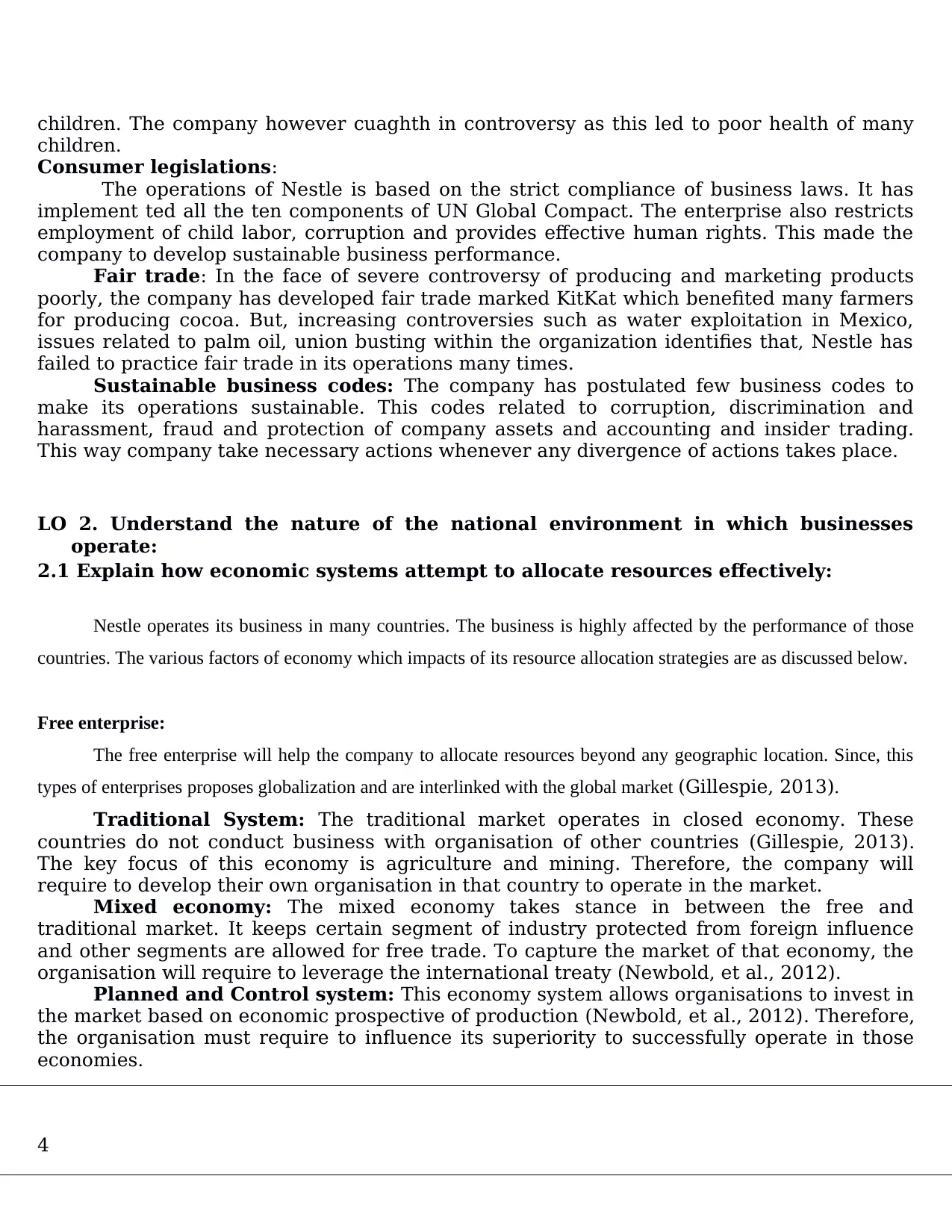
children. The company however cuaghth in controversy as this led to poor health of many
children.
Consumer legislations:
The operations of Nestle is based on the strict compliance of business laws. It has
implement ted all the ten components of UN Global Compact. The enterprise also restricts
employment of child labor, corruption and provides effective human rights. This made the
company to develop sustainable business performance.
Fair trade: In the face of severe controversy of producing and marketing products
poorly, the company has developed fair trade marked KitKat which benefited many farmers
for producing cocoa. But, increasing controversies such as water exploitation in Mexico,
issues related to palm oil, union busting within the organization identifies that, Nestle has
failed to practice fair trade in its operations many times.
Sustainable business codes: The company has postulated few business codes to
make its operations sustainable. This codes related to corruption, discrimination and
harassment, fraud and protection of company assets and accounting and insider trading.
This way company take necessary actions whenever any divergence of actions takes place.
LO 2. Understand the nature of the national environment in which businesses
operate:
2.1 Explain how economic systems attempt to allocate resources effectively:
Nestle operates its business in many countries. The business is highly affected by the performance of those
countries. The various factors of economy which impacts of its resource allocation strategies are as discussed below.
Free enterprise:
The free enterprise will help the company to allocate resources beyond any geographic location. Since, this
types of enterprises proposes globalization and are interlinked with the global market (Gillespie, 2013).
Traditional System: The traditional market operates in closed economy. These
countries do not conduct business with organisation of other countries (Gillespie, 2013).
The key focus of this economy is agriculture and mining. Therefore, the company will
require to develop their own organisation in that country to operate in the market.
Mixed economy: The mixed economy takes stance in between the free and
traditional market. It keeps certain segment of industry protected from foreign influence
and other segments are allowed for free trade. To capture the market of that economy, the
organisation will require to leverage the international treaty (Newbold, et al., 2012).
Planned and Control system: This economy system allows organisations to invest in
the market based on economic prospective of production (Newbold, et al., 2012). Therefore,
the organisation must require to influence its superiority to successfully operate in those
economies.
4
children.
Consumer legislations:
The operations of Nestle is based on the strict compliance of business laws. It has
implement ted all the ten components of UN Global Compact. The enterprise also restricts
employment of child labor, corruption and provides effective human rights. This made the
company to develop sustainable business performance.
Fair trade: In the face of severe controversy of producing and marketing products
poorly, the company has developed fair trade marked KitKat which benefited many farmers
for producing cocoa. But, increasing controversies such as water exploitation in Mexico,
issues related to palm oil, union busting within the organization identifies that, Nestle has
failed to practice fair trade in its operations many times.
Sustainable business codes: The company has postulated few business codes to
make its operations sustainable. This codes related to corruption, discrimination and
harassment, fraud and protection of company assets and accounting and insider trading.
This way company take necessary actions whenever any divergence of actions takes place.
LO 2. Understand the nature of the national environment in which businesses
operate:
2.1 Explain how economic systems attempt to allocate resources effectively:
Nestle operates its business in many countries. The business is highly affected by the performance of those
countries. The various factors of economy which impacts of its resource allocation strategies are as discussed below.
Free enterprise:
The free enterprise will help the company to allocate resources beyond any geographic location. Since, this
types of enterprises proposes globalization and are interlinked with the global market (Gillespie, 2013).
Traditional System: The traditional market operates in closed economy. These
countries do not conduct business with organisation of other countries (Gillespie, 2013).
The key focus of this economy is agriculture and mining. Therefore, the company will
require to develop their own organisation in that country to operate in the market.
Mixed economy: The mixed economy takes stance in between the free and
traditional market. It keeps certain segment of industry protected from foreign influence
and other segments are allowed for free trade. To capture the market of that economy, the
organisation will require to leverage the international treaty (Newbold, et al., 2012).
Planned and Control system: This economy system allows organisations to invest in
the market based on economic prospective of production (Newbold, et al., 2012). Therefore,
the organisation must require to influence its superiority to successfully operate in those
economies.
4
Paraphrase This Document
Need a fresh take? Get an instant paraphrase of this document with our AI Paraphraser
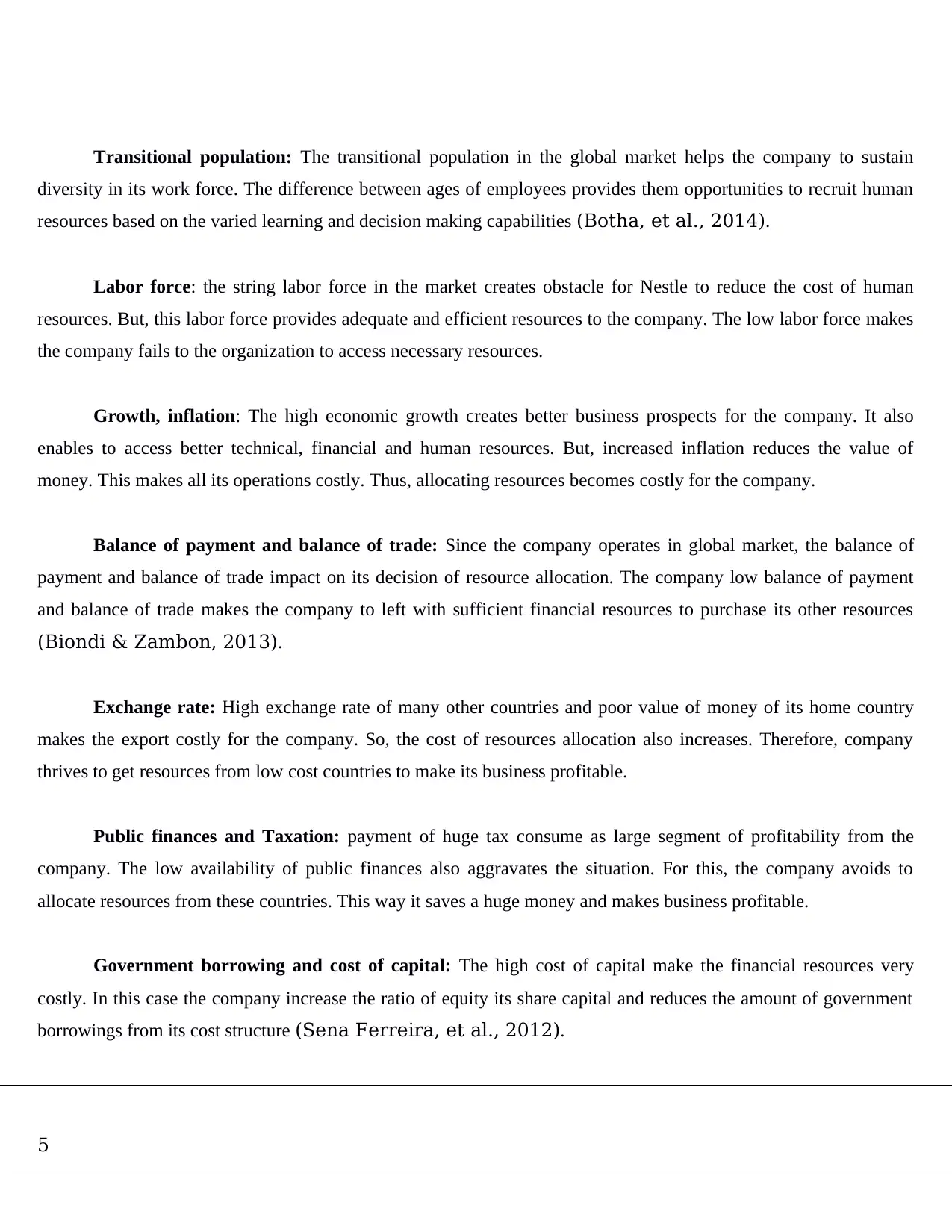
Transitional population: The transitional population in the global market helps the company to sustain
diversity in its work force. The difference between ages of employees provides them opportunities to recruit human
resources based on the varied learning and decision making capabilities (Botha, et al., 2014).
Labor force: the string labor force in the market creates obstacle for Nestle to reduce the cost of human
resources. But, this labor force provides adequate and efficient resources to the company. The low labor force makes
the company fails to the organization to access necessary resources.
Growth, inflation: The high economic growth creates better business prospects for the company. It also
enables to access better technical, financial and human resources. But, increased inflation reduces the value of
money. This makes all its operations costly. Thus, allocating resources becomes costly for the company.
Balance of payment and balance of trade: Since the company operates in global market, the balance of
payment and balance of trade impact on its decision of resource allocation. The company low balance of payment
and balance of trade makes the company to left with sufficient financial resources to purchase its other resources
(Biondi & Zambon, 2013).
Exchange rate: High exchange rate of many other countries and poor value of money of its home country
makes the export costly for the company. So, the cost of resources allocation also increases. Therefore, company
thrives to get resources from low cost countries to make its business profitable.
Public finances and Taxation: payment of huge tax consume as large segment of profitability from the
company. The low availability of public finances also aggravates the situation. For this, the company avoids to
allocate resources from these countries. This way it saves a huge money and makes business profitable.
Government borrowing and cost of capital: The high cost of capital make the financial resources very
costly. In this case the company increase the ratio of equity its share capital and reduces the amount of government
borrowings from its cost structure (Sena Ferreira, et al., 2012).
5
diversity in its work force. The difference between ages of employees provides them opportunities to recruit human
resources based on the varied learning and decision making capabilities (Botha, et al., 2014).
Labor force: the string labor force in the market creates obstacle for Nestle to reduce the cost of human
resources. But, this labor force provides adequate and efficient resources to the company. The low labor force makes
the company fails to the organization to access necessary resources.
Growth, inflation: The high economic growth creates better business prospects for the company. It also
enables to access better technical, financial and human resources. But, increased inflation reduces the value of
money. This makes all its operations costly. Thus, allocating resources becomes costly for the company.
Balance of payment and balance of trade: Since the company operates in global market, the balance of
payment and balance of trade impact on its decision of resource allocation. The company low balance of payment
and balance of trade makes the company to left with sufficient financial resources to purchase its other resources
(Biondi & Zambon, 2013).
Exchange rate: High exchange rate of many other countries and poor value of money of its home country
makes the export costly for the company. So, the cost of resources allocation also increases. Therefore, company
thrives to get resources from low cost countries to make its business profitable.
Public finances and Taxation: payment of huge tax consume as large segment of profitability from the
company. The low availability of public finances also aggravates the situation. For this, the company avoids to
allocate resources from these countries. This way it saves a huge money and makes business profitable.
Government borrowing and cost of capital: The high cost of capital make the financial resources very
costly. In this case the company increase the ratio of equity its share capital and reduces the amount of government
borrowings from its cost structure (Sena Ferreira, et al., 2012).
5
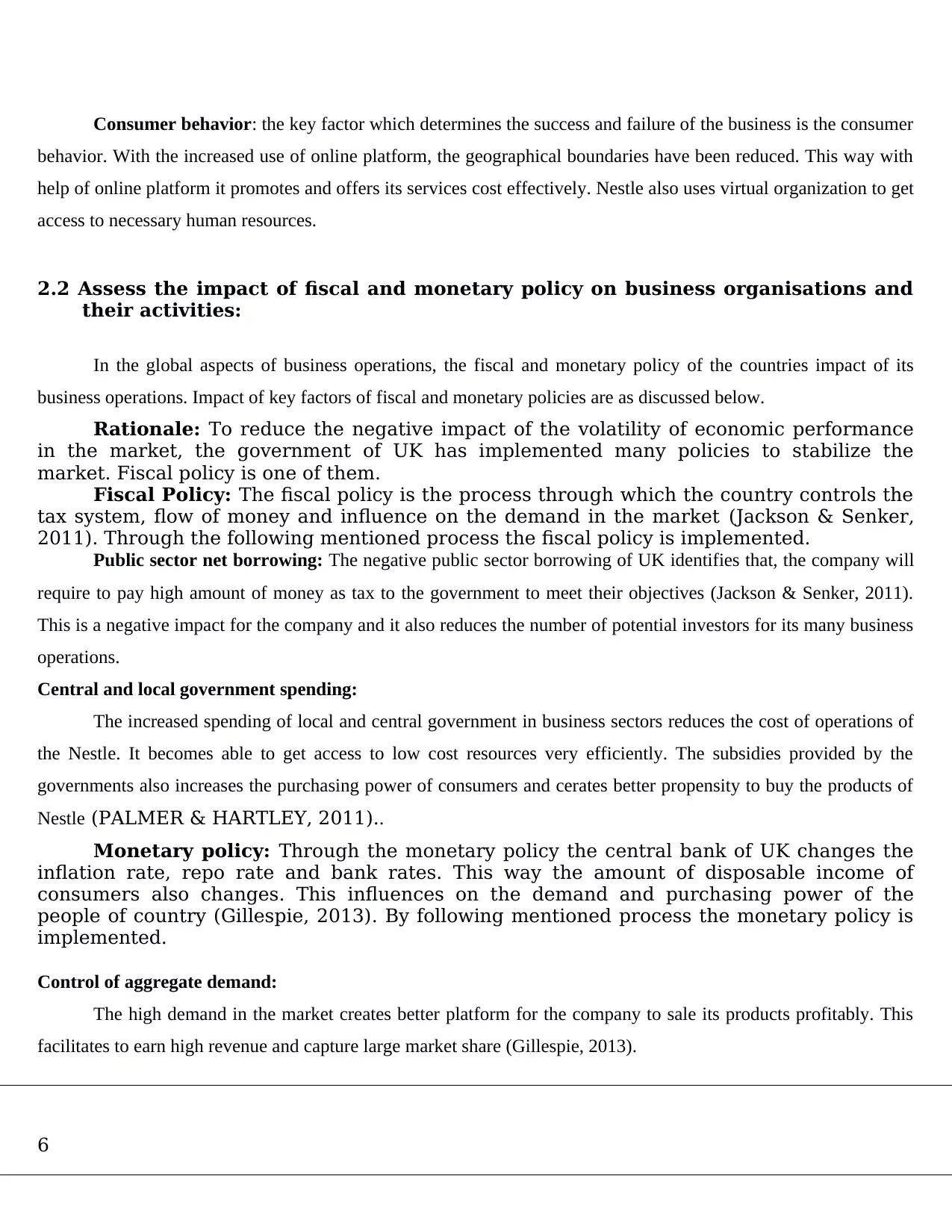
Consumer behavior: the key factor which determines the success and failure of the business is the consumer
behavior. With the increased use of online platform, the geographical boundaries have been reduced. This way with
help of online platform it promotes and offers its services cost effectively. Nestle also uses virtual organization to get
access to necessary human resources.
2.2 Assess the impact of fiscal and monetary policy on business organisations and
their activities:
In the global aspects of business operations, the fiscal and monetary policy of the countries impact of its
business operations. Impact of key factors of fiscal and monetary policies are as discussed below.
Rationale: To reduce the negative impact of the volatility of economic performance
in the market, the government of UK has implemented many policies to stabilize the
market. Fiscal policy is one of them.
Fiscal Policy: The fiscal policy is the process through which the country controls the
tax system, flow of money and influence on the demand in the market (Jackson & Senker,
2011). Through the following mentioned process the fiscal policy is implemented.
Public sector net borrowing: The negative public sector borrowing of UK identifies that, the company will
require to pay high amount of money as tax to the government to meet their objectives (Jackson & Senker, 2011).
This is a negative impact for the company and it also reduces the number of potential investors for its many business
operations.
Central and local government spending:
The increased spending of local and central government in business sectors reduces the cost of operations of
the Nestle. It becomes able to get access to low cost resources very efficiently. The subsidies provided by the
governments also increases the purchasing power of consumers and cerates better propensity to buy the products of
Nestle (PALMER & HARTLEY, 2011)..
Monetary policy: Through the monetary policy the central bank of UK changes the
inflation rate, repo rate and bank rates. This way the amount of disposable income of
consumers also changes. This influences on the demand and purchasing power of the
people of country (Gillespie, 2013). By following mentioned process the monetary policy is
implemented.
Control of aggregate demand:
The high demand in the market creates better platform for the company to sale its products profitably. This
facilitates to earn high revenue and capture large market share (Gillespie, 2013).
6
behavior. With the increased use of online platform, the geographical boundaries have been reduced. This way with
help of online platform it promotes and offers its services cost effectively. Nestle also uses virtual organization to get
access to necessary human resources.
2.2 Assess the impact of fiscal and monetary policy on business organisations and
their activities:
In the global aspects of business operations, the fiscal and monetary policy of the countries impact of its
business operations. Impact of key factors of fiscal and monetary policies are as discussed below.
Rationale: To reduce the negative impact of the volatility of economic performance
in the market, the government of UK has implemented many policies to stabilize the
market. Fiscal policy is one of them.
Fiscal Policy: The fiscal policy is the process through which the country controls the
tax system, flow of money and influence on the demand in the market (Jackson & Senker,
2011). Through the following mentioned process the fiscal policy is implemented.
Public sector net borrowing: The negative public sector borrowing of UK identifies that, the company will
require to pay high amount of money as tax to the government to meet their objectives (Jackson & Senker, 2011).
This is a negative impact for the company and it also reduces the number of potential investors for its many business
operations.
Central and local government spending:
The increased spending of local and central government in business sectors reduces the cost of operations of
the Nestle. It becomes able to get access to low cost resources very efficiently. The subsidies provided by the
governments also increases the purchasing power of consumers and cerates better propensity to buy the products of
Nestle (PALMER & HARTLEY, 2011)..
Monetary policy: Through the monetary policy the central bank of UK changes the
inflation rate, repo rate and bank rates. This way the amount of disposable income of
consumers also changes. This influences on the demand and purchasing power of the
people of country (Gillespie, 2013). By following mentioned process the monetary policy is
implemented.
Control of aggregate demand:
The high demand in the market creates better platform for the company to sale its products profitably. This
facilitates to earn high revenue and capture large market share (Gillespie, 2013).
6
⊘ This is a preview!⊘
Do you want full access?
Subscribe today to unlock all pages.

Trusted by 1+ million students worldwide
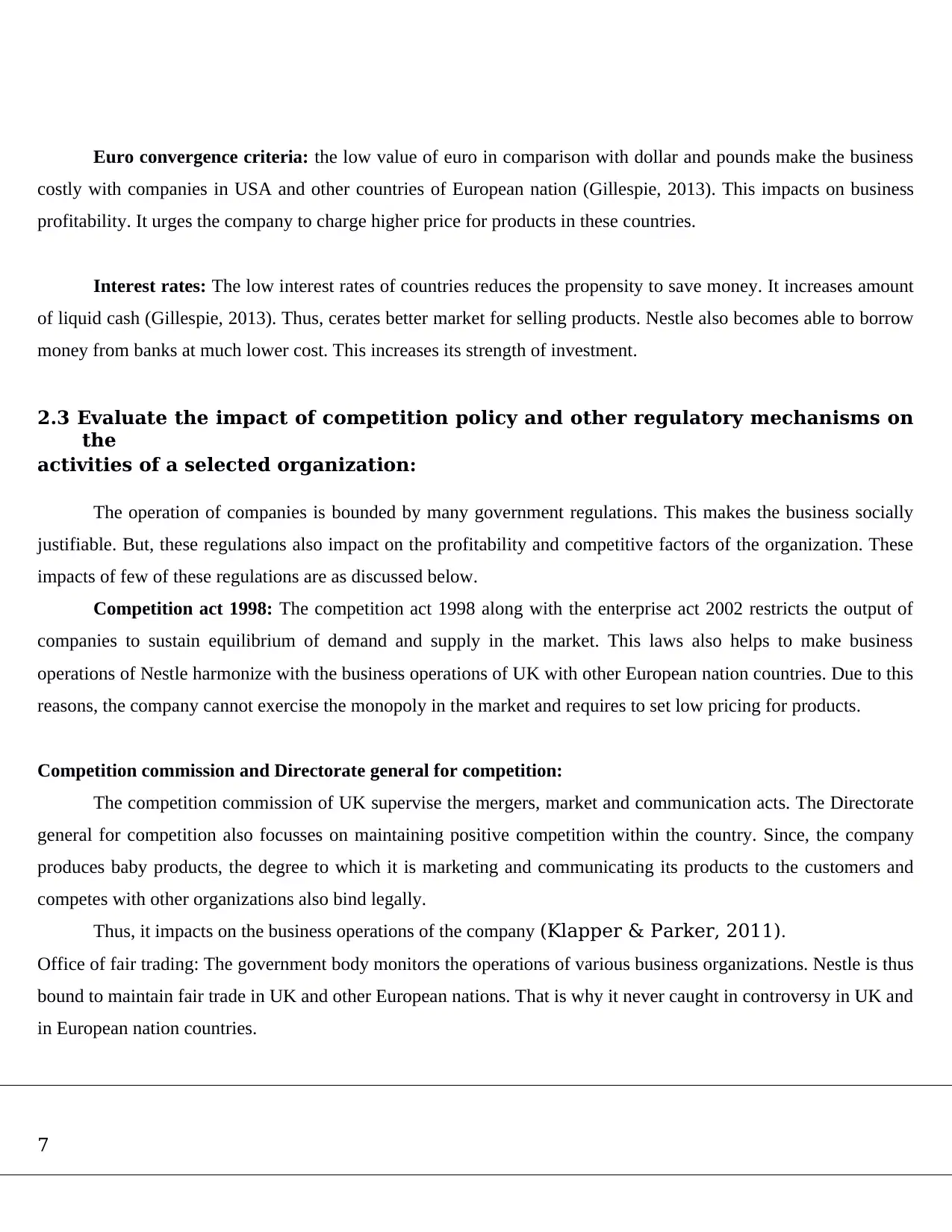
Euro convergence criteria: the low value of euro in comparison with dollar and pounds make the business
costly with companies in USA and other countries of European nation (Gillespie, 2013). This impacts on business
profitability. It urges the company to charge higher price for products in these countries.
Interest rates: The low interest rates of countries reduces the propensity to save money. It increases amount
of liquid cash (Gillespie, 2013). Thus, cerates better market for selling products. Nestle also becomes able to borrow
money from banks at much lower cost. This increases its strength of investment.
2.3 Evaluate the impact of competition policy and other regulatory mechanisms on
the
activities of a selected organization:
The operation of companies is bounded by many government regulations. This makes the business socially
justifiable. But, these regulations also impact on the profitability and competitive factors of the organization. These
impacts of few of these regulations are as discussed below.
Competition act 1998: The competition act 1998 along with the enterprise act 2002 restricts the output of
companies to sustain equilibrium of demand and supply in the market. This laws also helps to make business
operations of Nestle harmonize with the business operations of UK with other European nation countries. Due to this
reasons, the company cannot exercise the monopoly in the market and requires to set low pricing for products.
Competition commission and Directorate general for competition:
The competition commission of UK supervise the mergers, market and communication acts. The Directorate
general for competition also focusses on maintaining positive competition within the country. Since, the company
produces baby products, the degree to which it is marketing and communicating its products to the customers and
competes with other organizations also bind legally.
Thus, it impacts on the business operations of the company (Klapper & Parker, 2011).
Office of fair trading: The government body monitors the operations of various business organizations. Nestle is thus
bound to maintain fair trade in UK and other European nations. That is why it never caught in controversy in UK and
in European nation countries.
7
costly with companies in USA and other countries of European nation (Gillespie, 2013). This impacts on business
profitability. It urges the company to charge higher price for products in these countries.
Interest rates: The low interest rates of countries reduces the propensity to save money. It increases amount
of liquid cash (Gillespie, 2013). Thus, cerates better market for selling products. Nestle also becomes able to borrow
money from banks at much lower cost. This increases its strength of investment.
2.3 Evaluate the impact of competition policy and other regulatory mechanisms on
the
activities of a selected organization:
The operation of companies is bounded by many government regulations. This makes the business socially
justifiable. But, these regulations also impact on the profitability and competitive factors of the organization. These
impacts of few of these regulations are as discussed below.
Competition act 1998: The competition act 1998 along with the enterprise act 2002 restricts the output of
companies to sustain equilibrium of demand and supply in the market. This laws also helps to make business
operations of Nestle harmonize with the business operations of UK with other European nation countries. Due to this
reasons, the company cannot exercise the monopoly in the market and requires to set low pricing for products.
Competition commission and Directorate general for competition:
The competition commission of UK supervise the mergers, market and communication acts. The Directorate
general for competition also focusses on maintaining positive competition within the country. Since, the company
produces baby products, the degree to which it is marketing and communicating its products to the customers and
competes with other organizations also bind legally.
Thus, it impacts on the business operations of the company (Klapper & Parker, 2011).
Office of fair trading: The government body monitors the operations of various business organizations. Nestle is thus
bound to maintain fair trade in UK and other European nations. That is why it never caught in controversy in UK and
in European nation countries.
7
Paraphrase This Document
Need a fresh take? Get an instant paraphrase of this document with our AI Paraphraser
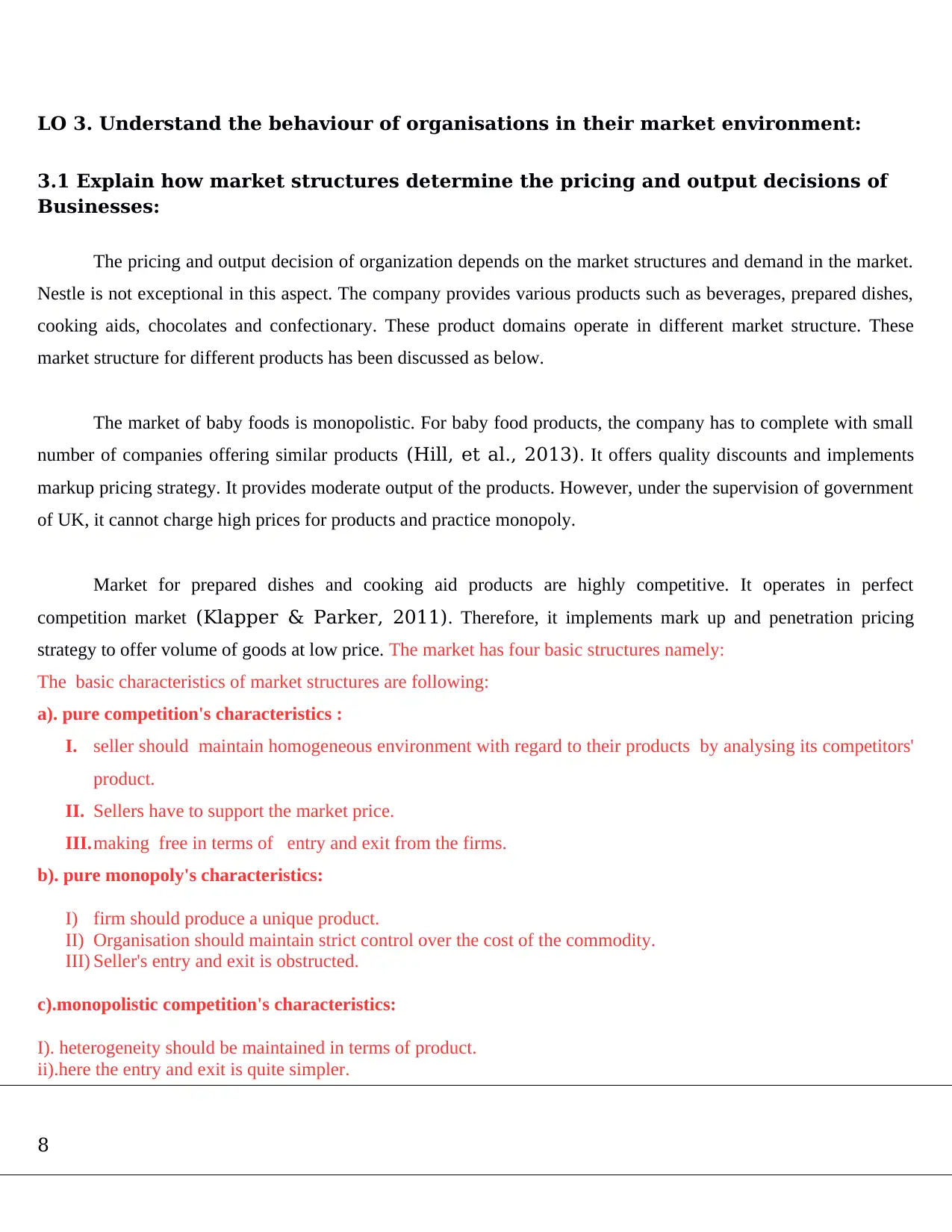
LO 3. Understand the behaviour of organisations in their market environment:
3.1 Explain how market structures determine the pricing and output decisions of
Businesses:
The pricing and output decision of organization depends on the market structures and demand in the market.
Nestle is not exceptional in this aspect. The company provides various products such as beverages, prepared dishes,
cooking aids, chocolates and confectionary. These product domains operate in different market structure. These
market structure for different products has been discussed as below.
The market of baby foods is monopolistic. For baby food products, the company has to complete with small
number of companies offering similar products (Hill, et al., 2013). It offers quality discounts and implements
markup pricing strategy. It provides moderate output of the products. However, under the supervision of government
of UK, it cannot charge high prices for products and practice monopoly.
Market for prepared dishes and cooking aid products are highly competitive. It operates in perfect
competition market (Klapper & Parker, 2011). Therefore, it implements mark up and penetration pricing
strategy to offer volume of goods at low price. The market has four basic structures namely:
The basic characteristics of market structures are following:
a). pure competition's characteristics :
I. seller should maintain homogeneous environment with regard to their products by analysing its competitors'
product.
II. Sellers have to support the market price.
III.making free in terms of entry and exit from the firms.
b). pure monopoly's characteristics:
I) firm should produce a unique product.
II) Organisation should maintain strict control over the cost of the commodity.
III) Seller's entry and exit is obstructed.
c).monopolistic competition's characteristics:
I). heterogeneity should be maintained in terms of product.
ii).here the entry and exit is quite simpler.
8
3.1 Explain how market structures determine the pricing and output decisions of
Businesses:
The pricing and output decision of organization depends on the market structures and demand in the market.
Nestle is not exceptional in this aspect. The company provides various products such as beverages, prepared dishes,
cooking aids, chocolates and confectionary. These product domains operate in different market structure. These
market structure for different products has been discussed as below.
The market of baby foods is monopolistic. For baby food products, the company has to complete with small
number of companies offering similar products (Hill, et al., 2013). It offers quality discounts and implements
markup pricing strategy. It provides moderate output of the products. However, under the supervision of government
of UK, it cannot charge high prices for products and practice monopoly.
Market for prepared dishes and cooking aid products are highly competitive. It operates in perfect
competition market (Klapper & Parker, 2011). Therefore, it implements mark up and penetration pricing
strategy to offer volume of goods at low price. The market has four basic structures namely:
The basic characteristics of market structures are following:
a). pure competition's characteristics :
I. seller should maintain homogeneous environment with regard to their products by analysing its competitors'
product.
II. Sellers have to support the market price.
III.making free in terms of entry and exit from the firms.
b). pure monopoly's characteristics:
I) firm should produce a unique product.
II) Organisation should maintain strict control over the cost of the commodity.
III) Seller's entry and exit is obstructed.
c).monopolistic competition's characteristics:
I). heterogeneity should be maintained in terms of product.
ii).here the entry and exit is quite simpler.
8
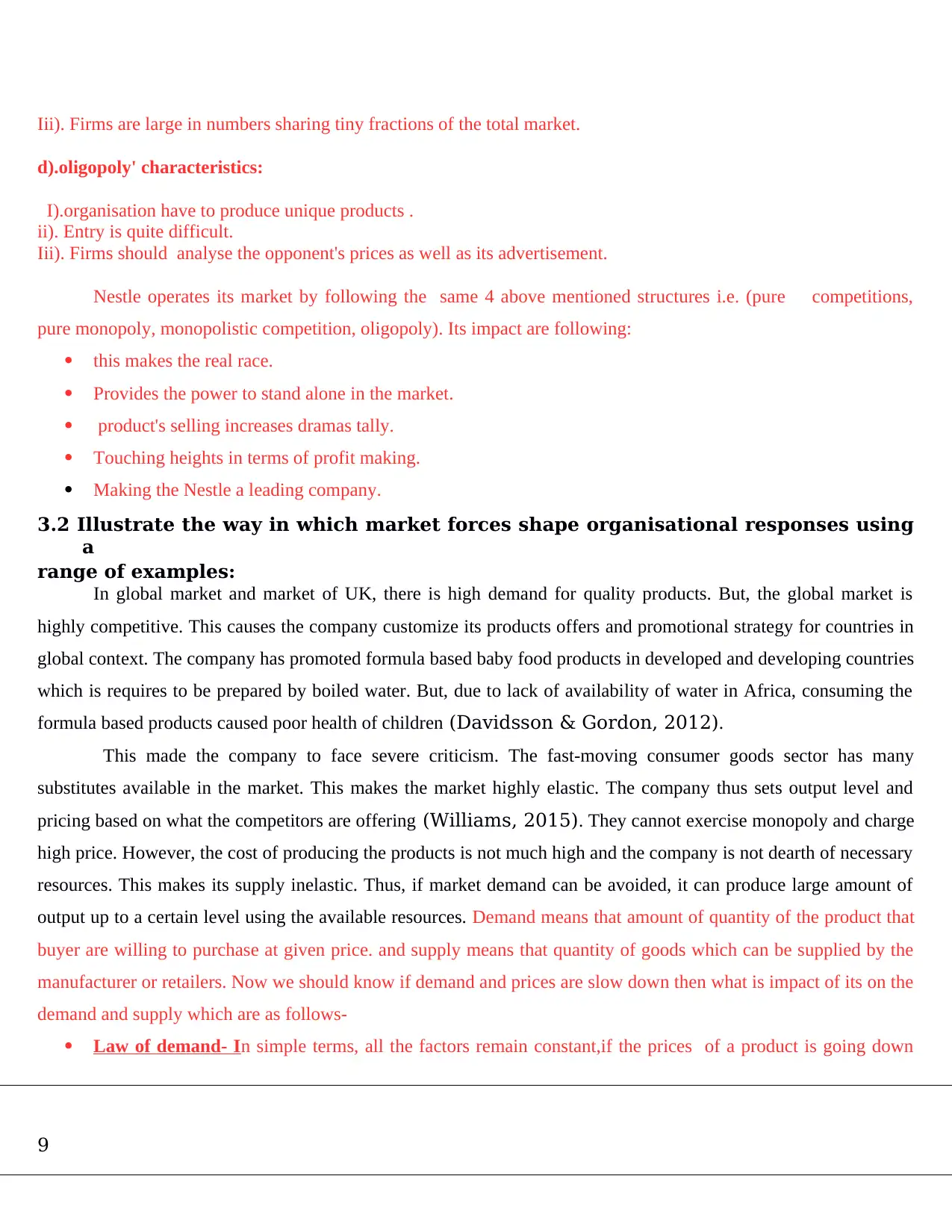
Iii). Firms are large in numbers sharing tiny fractions of the total market.
d).oligopoly' characteristics:
I).organisation have to produce unique products .
ii). Entry is quite difficult.
Iii). Firms should analyse the opponent's prices as well as its advertisement.
Nestle operates its market by following the same 4 above mentioned structures i.e. (pure competitions,
pure monopoly, monopolistic competition, oligopoly). Its impact are following:
this makes the real race.
Provides the power to stand alone in the market.
product's selling increases dramas tally.
Touching heights in terms of profit making.
Making the Nestle a leading company.
3.2 Illustrate the way in which market forces shape organisational responses using
a
range of examples:
In global market and market of UK, there is high demand for quality products. But, the global market is
highly competitive. This causes the company customize its products offers and promotional strategy for countries in
global context. The company has promoted formula based baby food products in developed and developing countries
which is requires to be prepared by boiled water. But, due to lack of availability of water in Africa, consuming the
formula based products caused poor health of children (Davidsson & Gordon, 2012).
This made the company to face severe criticism. The fast-moving consumer goods sector has many
substitutes available in the market. This makes the market highly elastic. The company thus sets output level and
pricing based on what the competitors are offering (Williams, 2015). They cannot exercise monopoly and charge
high price. However, the cost of producing the products is not much high and the company is not dearth of necessary
resources. This makes its supply inelastic. Thus, if market demand can be avoided, it can produce large amount of
output up to a certain level using the available resources. Demand means that amount of quantity of the product that
buyer are willing to purchase at given price. and supply means that quantity of goods which can be supplied by the
manufacturer or retailers. Now we should know if demand and prices are slow down then what is impact of its on the
demand and supply which are as follows-
Law of demand- In simple terms, all the factors remain constant,if the prices of a product is going down
9
d).oligopoly' characteristics:
I).organisation have to produce unique products .
ii). Entry is quite difficult.
Iii). Firms should analyse the opponent's prices as well as its advertisement.
Nestle operates its market by following the same 4 above mentioned structures i.e. (pure competitions,
pure monopoly, monopolistic competition, oligopoly). Its impact are following:
this makes the real race.
Provides the power to stand alone in the market.
product's selling increases dramas tally.
Touching heights in terms of profit making.
Making the Nestle a leading company.
3.2 Illustrate the way in which market forces shape organisational responses using
a
range of examples:
In global market and market of UK, there is high demand for quality products. But, the global market is
highly competitive. This causes the company customize its products offers and promotional strategy for countries in
global context. The company has promoted formula based baby food products in developed and developing countries
which is requires to be prepared by boiled water. But, due to lack of availability of water in Africa, consuming the
formula based products caused poor health of children (Davidsson & Gordon, 2012).
This made the company to face severe criticism. The fast-moving consumer goods sector has many
substitutes available in the market. This makes the market highly elastic. The company thus sets output level and
pricing based on what the competitors are offering (Williams, 2015). They cannot exercise monopoly and charge
high price. However, the cost of producing the products is not much high and the company is not dearth of necessary
resources. This makes its supply inelastic. Thus, if market demand can be avoided, it can produce large amount of
output up to a certain level using the available resources. Demand means that amount of quantity of the product that
buyer are willing to purchase at given price. and supply means that quantity of goods which can be supplied by the
manufacturer or retailers. Now we should know if demand and prices are slow down then what is impact of its on the
demand and supply which are as follows-
Law of demand- In simple terms, all the factors remain constant,if the prices of a product is going down
9
⊘ This is a preview!⊘
Do you want full access?
Subscribe today to unlock all pages.

Trusted by 1+ million students worldwide
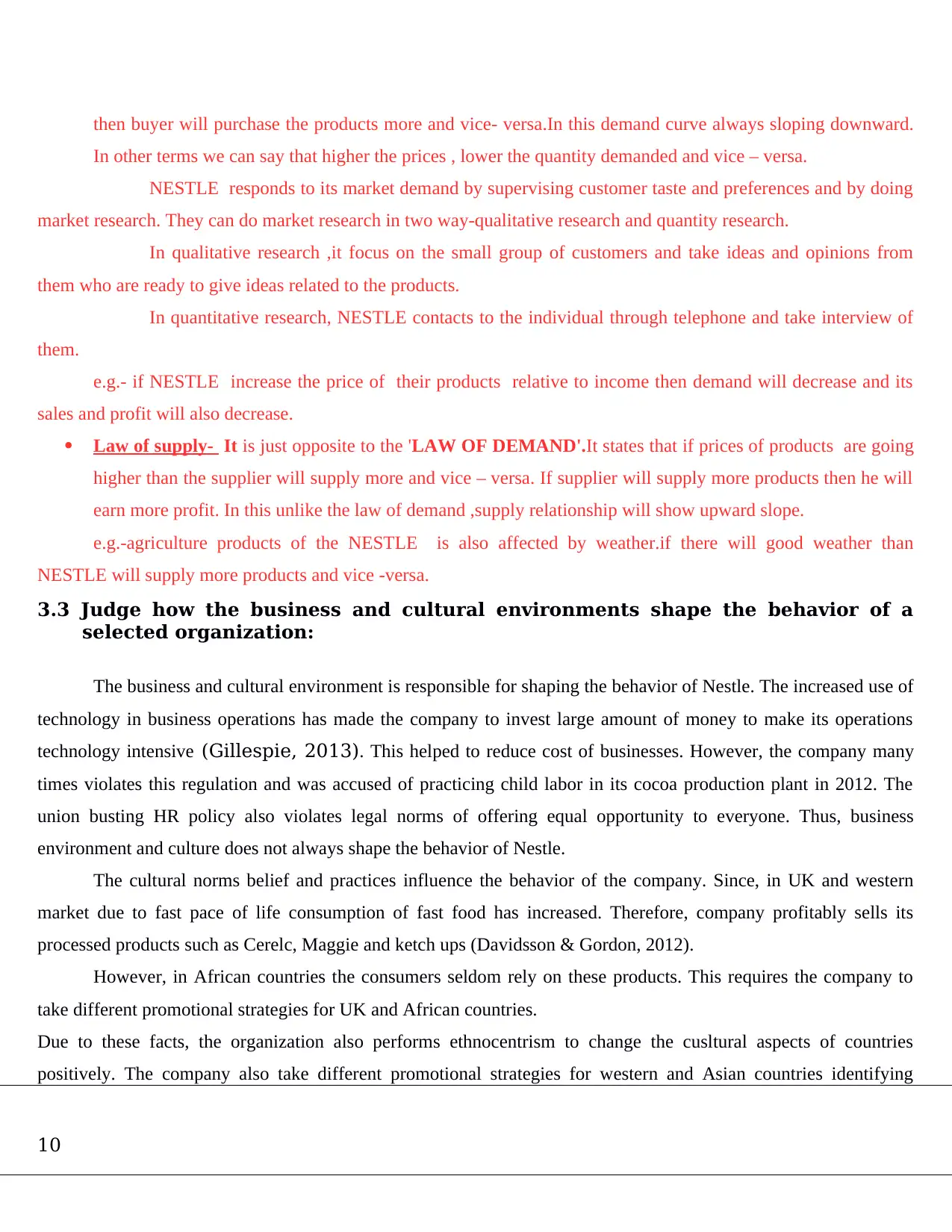
then buyer will purchase the products more and vice- versa.In this demand curve always sloping downward.
In other terms we can say that higher the prices , lower the quantity demanded and vice – versa.
NESTLE responds to its market demand by supervising customer taste and preferences and by doing
market research. They can do market research in two way-qualitative research and quantity research.
In qualitative research ,it focus on the small group of customers and take ideas and opinions from
them who are ready to give ideas related to the products.
In quantitative research, NESTLE contacts to the individual through telephone and take interview of
them.
e.g.- if NESTLE increase the price of their products relative to income then demand will decrease and its
sales and profit will also decrease.
Law of supply- It is just opposite to the 'LAW OF DEMAND'.It states that if prices of products are going
higher than the supplier will supply more and vice – versa. If supplier will supply more products then he will
earn more profit. In this unlike the law of demand ,supply relationship will show upward slope.
e.g.-agriculture products of the NESTLE is also affected by weather.if there will good weather than
NESTLE will supply more products and vice -versa.
3.3 Judge how the business and cultural environments shape the behavior of a
selected organization:
The business and cultural environment is responsible for shaping the behavior of Nestle. The increased use of
technology in business operations has made the company to invest large amount of money to make its operations
technology intensive (Gillespie, 2013). This helped to reduce cost of businesses. However, the company many
times violates this regulation and was accused of practicing child labor in its cocoa production plant in 2012. The
union busting HR policy also violates legal norms of offering equal opportunity to everyone. Thus, business
environment and culture does not always shape the behavior of Nestle.
The cultural norms belief and practices influence the behavior of the company. Since, in UK and western
market due to fast pace of life consumption of fast food has increased. Therefore, company profitably sells its
processed products such as Cerelc, Maggie and ketch ups (Davidsson & Gordon, 2012).
However, in African countries the consumers seldom rely on these products. This requires the company to
take different promotional strategies for UK and African countries.
Due to these facts, the organization also performs ethnocentrism to change the cusltural aspects of countries
positively. The company also take different promotional strategies for western and Asian countries identifying
10
In other terms we can say that higher the prices , lower the quantity demanded and vice – versa.
NESTLE responds to its market demand by supervising customer taste and preferences and by doing
market research. They can do market research in two way-qualitative research and quantity research.
In qualitative research ,it focus on the small group of customers and take ideas and opinions from
them who are ready to give ideas related to the products.
In quantitative research, NESTLE contacts to the individual through telephone and take interview of
them.
e.g.- if NESTLE increase the price of their products relative to income then demand will decrease and its
sales and profit will also decrease.
Law of supply- It is just opposite to the 'LAW OF DEMAND'.It states that if prices of products are going
higher than the supplier will supply more and vice – versa. If supplier will supply more products then he will
earn more profit. In this unlike the law of demand ,supply relationship will show upward slope.
e.g.-agriculture products of the NESTLE is also affected by weather.if there will good weather than
NESTLE will supply more products and vice -versa.
3.3 Judge how the business and cultural environments shape the behavior of a
selected organization:
The business and cultural environment is responsible for shaping the behavior of Nestle. The increased use of
technology in business operations has made the company to invest large amount of money to make its operations
technology intensive (Gillespie, 2013). This helped to reduce cost of businesses. However, the company many
times violates this regulation and was accused of practicing child labor in its cocoa production plant in 2012. The
union busting HR policy also violates legal norms of offering equal opportunity to everyone. Thus, business
environment and culture does not always shape the behavior of Nestle.
The cultural norms belief and practices influence the behavior of the company. Since, in UK and western
market due to fast pace of life consumption of fast food has increased. Therefore, company profitably sells its
processed products such as Cerelc, Maggie and ketch ups (Davidsson & Gordon, 2012).
However, in African countries the consumers seldom rely on these products. This requires the company to
take different promotional strategies for UK and African countries.
Due to these facts, the organization also performs ethnocentrism to change the cusltural aspects of countries
positively. The company also take different promotional strategies for western and Asian countries identifying
10
Paraphrase This Document
Need a fresh take? Get an instant paraphrase of this document with our AI Paraphraser
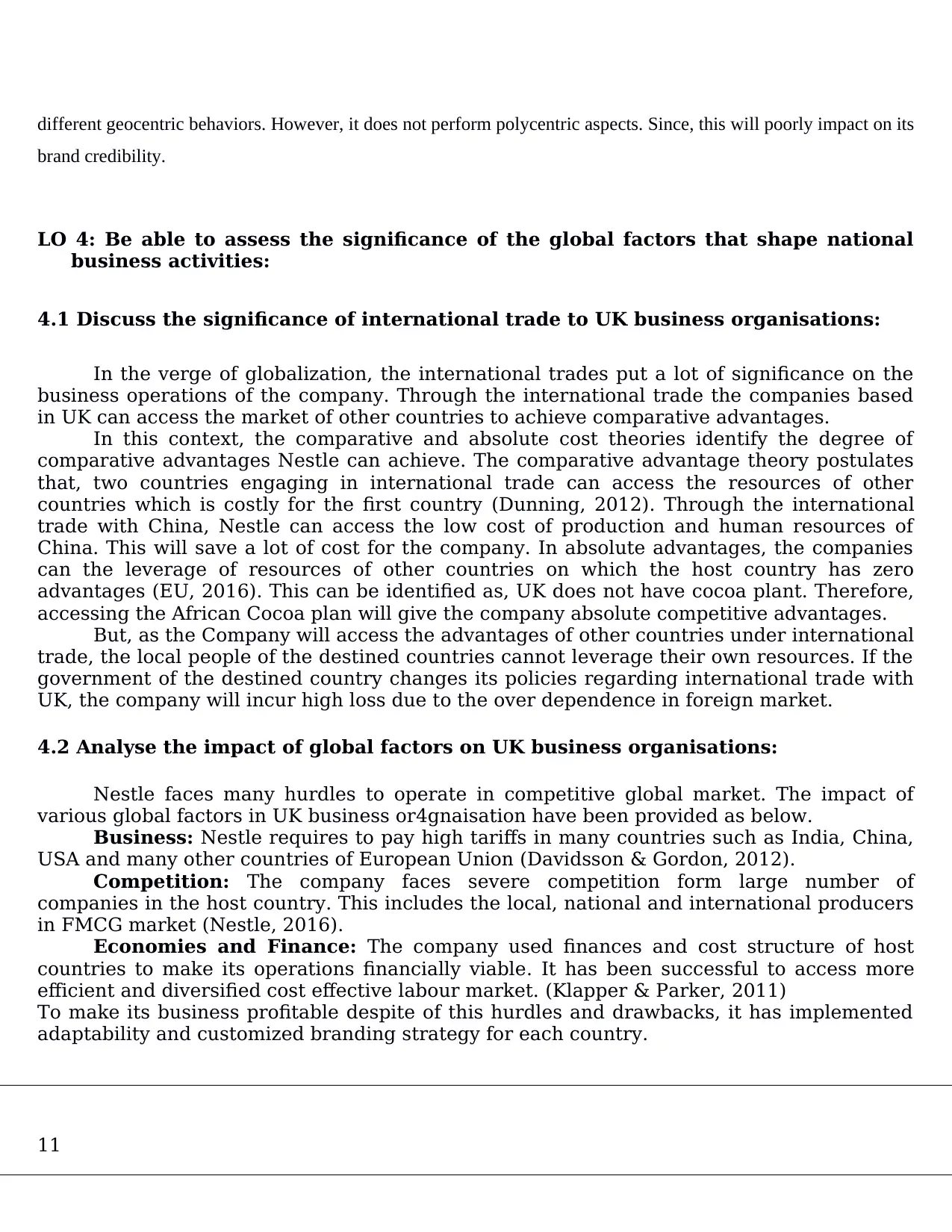
different geocentric behaviors. However, it does not perform polycentric aspects. Since, this will poorly impact on its
brand credibility.
LO 4: Be able to assess the significance of the global factors that shape national
business activities:
4.1 Discuss the significance of international trade to UK business organisations:
In the verge of globalization, the international trades put a lot of significance on the
business operations of the company. Through the international trade the companies based
in UK can access the market of other countries to achieve comparative advantages.
In this context, the comparative and absolute cost theories identify the degree of
comparative advantages Nestle can achieve. The comparative advantage theory postulates
that, two countries engaging in international trade can access the resources of other
countries which is costly for the first country (Dunning, 2012). Through the international
trade with China, Nestle can access the low cost of production and human resources of
China. This will save a lot of cost for the company. In absolute advantages, the companies
can the leverage of resources of other countries on which the host country has zero
advantages (EU, 2016). This can be identified as, UK does not have cocoa plant. Therefore,
accessing the African Cocoa plan will give the company absolute competitive advantages.
But, as the Company will access the advantages of other countries under international
trade, the local people of the destined countries cannot leverage their own resources. If the
government of the destined country changes its policies regarding international trade with
UK, the company will incur high loss due to the over dependence in foreign market.
4.2 Analyse the impact of global factors on UK business organisations:
Nestle faces many hurdles to operate in competitive global market. The impact of
various global factors in UK business or4gnaisation have been provided as below.
Business: Nestle requires to pay high tariffs in many countries such as India, China,
USA and many other countries of European Union (Davidsson & Gordon, 2012).
Competition: The company faces severe competition form large number of
companies in the host country. This includes the local, national and international producers
in FMCG market (Nestle, 2016).
Economies and Finance: The company used finances and cost structure of host
countries to make its operations financially viable. It has been successful to access more
efficient and diversified cost effective labour market. (Klapper & Parker, 2011)
To make its business profitable despite of this hurdles and drawbacks, it has implemented
adaptability and customized branding strategy for each country.
11
brand credibility.
LO 4: Be able to assess the significance of the global factors that shape national
business activities:
4.1 Discuss the significance of international trade to UK business organisations:
In the verge of globalization, the international trades put a lot of significance on the
business operations of the company. Through the international trade the companies based
in UK can access the market of other countries to achieve comparative advantages.
In this context, the comparative and absolute cost theories identify the degree of
comparative advantages Nestle can achieve. The comparative advantage theory postulates
that, two countries engaging in international trade can access the resources of other
countries which is costly for the first country (Dunning, 2012). Through the international
trade with China, Nestle can access the low cost of production and human resources of
China. This will save a lot of cost for the company. In absolute advantages, the companies
can the leverage of resources of other countries on which the host country has zero
advantages (EU, 2016). This can be identified as, UK does not have cocoa plant. Therefore,
accessing the African Cocoa plan will give the company absolute competitive advantages.
But, as the Company will access the advantages of other countries under international
trade, the local people of the destined countries cannot leverage their own resources. If the
government of the destined country changes its policies regarding international trade with
UK, the company will incur high loss due to the over dependence in foreign market.
4.2 Analyse the impact of global factors on UK business organisations:
Nestle faces many hurdles to operate in competitive global market. The impact of
various global factors in UK business or4gnaisation have been provided as below.
Business: Nestle requires to pay high tariffs in many countries such as India, China,
USA and many other countries of European Union (Davidsson & Gordon, 2012).
Competition: The company faces severe competition form large number of
companies in the host country. This includes the local, national and international producers
in FMCG market (Nestle, 2016).
Economies and Finance: The company used finances and cost structure of host
countries to make its operations financially viable. It has been successful to access more
efficient and diversified cost effective labour market. (Klapper & Parker, 2011)
To make its business profitable despite of this hurdles and drawbacks, it has implemented
adaptability and customized branding strategy for each country.
11
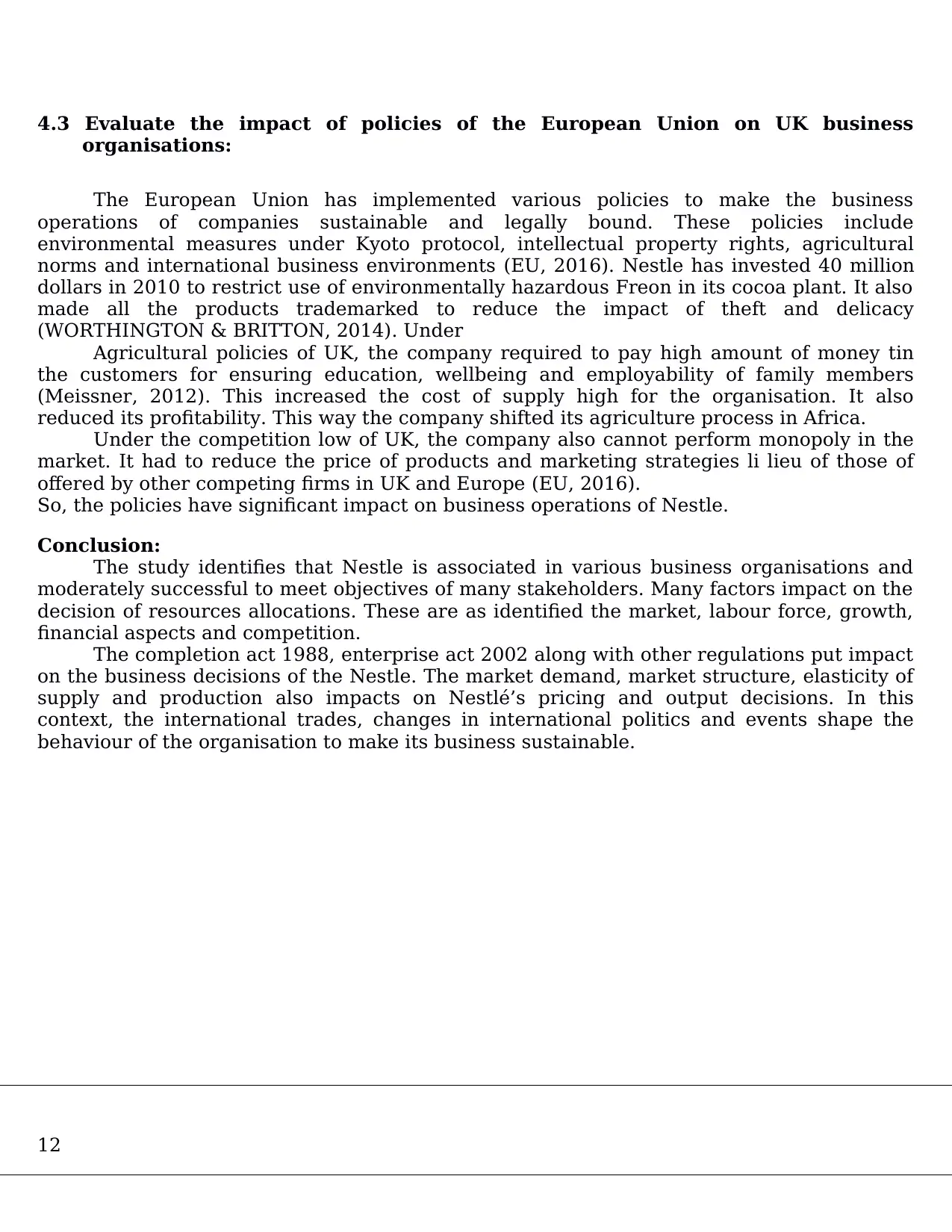
4.3 Evaluate the impact of policies of the European Union on UK business
organisations:
The European Union has implemented various policies to make the business
operations of companies sustainable and legally bound. These policies include
environmental measures under Kyoto protocol, intellectual property rights, agricultural
norms and international business environments (EU, 2016). Nestle has invested 40 million
dollars in 2010 to restrict use of environmentally hazardous Freon in its cocoa plant. It also
made all the products trademarked to reduce the impact of theft and delicacy
(WORTHINGTON & BRITTON, 2014). Under
Agricultural policies of UK, the company required to pay high amount of money tin
the customers for ensuring education, wellbeing and employability of family members
(Meissner, 2012). This increased the cost of supply high for the organisation. It also
reduced its profitability. This way the company shifted its agriculture process in Africa.
Under the competition low of UK, the company also cannot perform monopoly in the
market. It had to reduce the price of products and marketing strategies li lieu of those of
offered by other competing firms in UK and Europe (EU, 2016).
So, the policies have significant impact on business operations of Nestle.
Conclusion:
The study identifies that Nestle is associated in various business organisations and
moderately successful to meet objectives of many stakeholders. Many factors impact on the
decision of resources allocations. These are as identified the market, labour force, growth,
financial aspects and competition.
The completion act 1988, enterprise act 2002 along with other regulations put impact
on the business decisions of the Nestle. The market demand, market structure, elasticity of
supply and production also impacts on Nestlé’s pricing and output decisions. In this
context, the international trades, changes in international politics and events shape the
behaviour of the organisation to make its business sustainable.
12
organisations:
The European Union has implemented various policies to make the business
operations of companies sustainable and legally bound. These policies include
environmental measures under Kyoto protocol, intellectual property rights, agricultural
norms and international business environments (EU, 2016). Nestle has invested 40 million
dollars in 2010 to restrict use of environmentally hazardous Freon in its cocoa plant. It also
made all the products trademarked to reduce the impact of theft and delicacy
(WORTHINGTON & BRITTON, 2014). Under
Agricultural policies of UK, the company required to pay high amount of money tin
the customers for ensuring education, wellbeing and employability of family members
(Meissner, 2012). This increased the cost of supply high for the organisation. It also
reduced its profitability. This way the company shifted its agriculture process in Africa.
Under the competition low of UK, the company also cannot perform monopoly in the
market. It had to reduce the price of products and marketing strategies li lieu of those of
offered by other competing firms in UK and Europe (EU, 2016).
So, the policies have significant impact on business operations of Nestle.
Conclusion:
The study identifies that Nestle is associated in various business organisations and
moderately successful to meet objectives of many stakeholders. Many factors impact on the
decision of resources allocations. These are as identified the market, labour force, growth,
financial aspects and competition.
The completion act 1988, enterprise act 2002 along with other regulations put impact
on the business decisions of the Nestle. The market demand, market structure, elasticity of
supply and production also impacts on Nestlé’s pricing and output decisions. In this
context, the international trades, changes in international politics and events shape the
behaviour of the organisation to make its business sustainable.
12
⊘ This is a preview!⊘
Do you want full access?
Subscribe today to unlock all pages.

Trusted by 1+ million students worldwide
1 out of 14
Related Documents
Your All-in-One AI-Powered Toolkit for Academic Success.
+13062052269
info@desklib.com
Available 24*7 on WhatsApp / Email
![[object Object]](/_next/static/media/star-bottom.7253800d.svg)
Unlock your academic potential
Copyright © 2020–2025 A2Z Services. All Rights Reserved. Developed and managed by ZUCOL.





